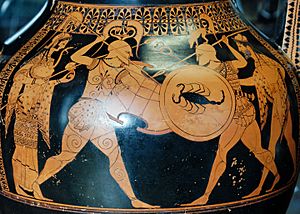Andokides (vase painter) facts for kids
The Andokides Painter was an ancient Athenian artist who painted vases. He was active from about 530 to 515 B.C. We don't know his real name because he didn't sign his artwork. Experts identified him by his unique painting style. He is named after the potter Andokides, whose name is on some of the vases the painter decorated.
Many people believe he invented the red-figure vase painting technique. He was certainly one of the very first artists to use this new style. About fourteen large vases called amphorae and two cups are thought to be his work. Six of these amphorae are "bilingual". This means they have scenes painted in both the red-figure and black-figure styles.
About the Artist
Experts have learned some things about the Andokides Painter by studying his artwork. As mentioned, many believe he created the red-figure painting style. It is also likely that he painted in the older black-figure style too. His artistic style suggests he might have been a student of the famous black-figure painter Exekias.
Some experts also see connections to art from Ionia in his work. This suggests he might have moved to Athens from East Greece. Another expert noted that the Andokides Painter was one of the first to use a white background on his vases. This might mean he also invented the white ground technique.
How Red-Figure Painting Began
The red-figure painting technique was invented around 525 B.C. We know this because the Andokides Painter's work is connected to a famous building. This building is the Siphnian Treasury at Delphi. The carvings on the Treasury show new artistic ideas. These include showing people from different angles and using foreshortening. These ideas are also seen in the new red-figure paintings, especially those by the Andokides Painter.
Also, some scenes on the Treasury, like the fight for the Delphic tripod, were not common in Athenian painting until the Andokides Painter's red-figure works. The link between the Treasury and the painter's work is so strong that some scholars think he might have helped create the Treasury's carvings. Perhaps he helped with the colors.
See also
 In Spanish: Pintor de Andócides para niños
In Spanish: Pintor de Andócides para niños
- List of Greek vase painters
Images for kids








